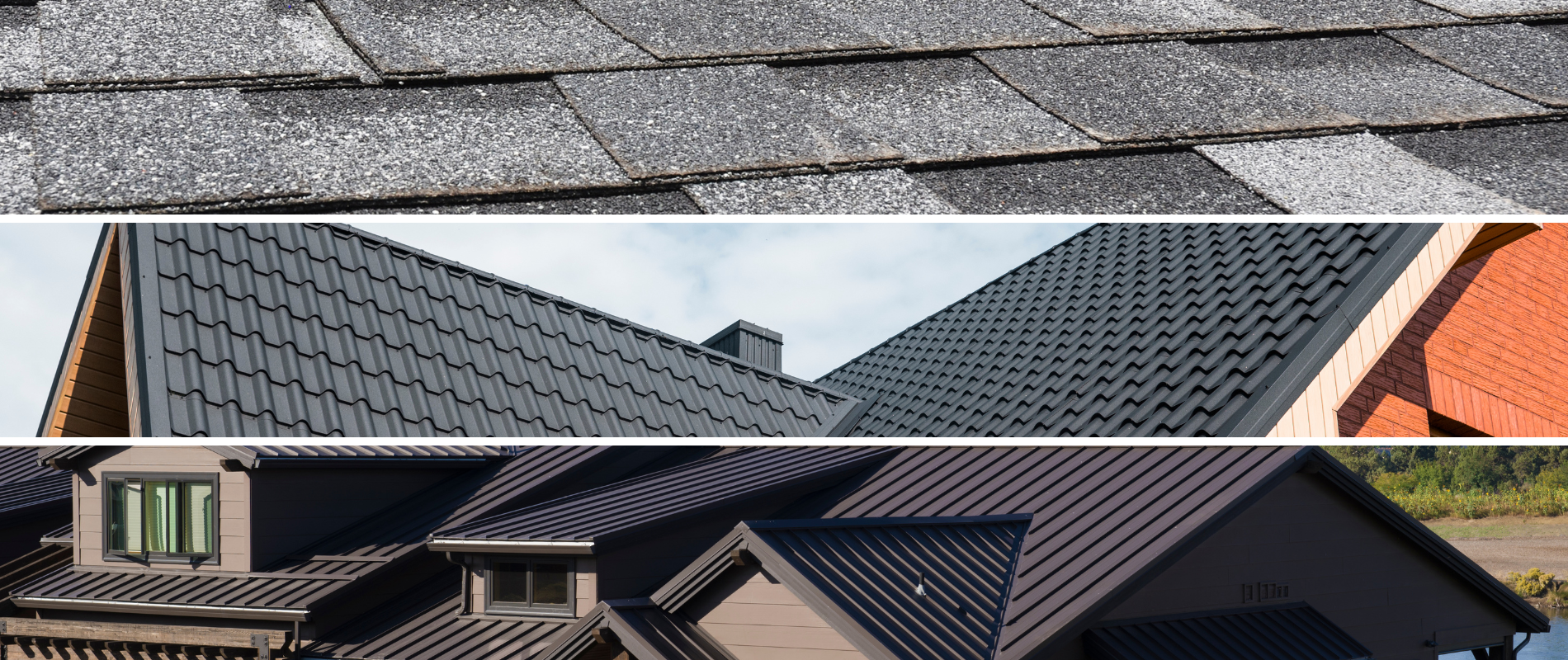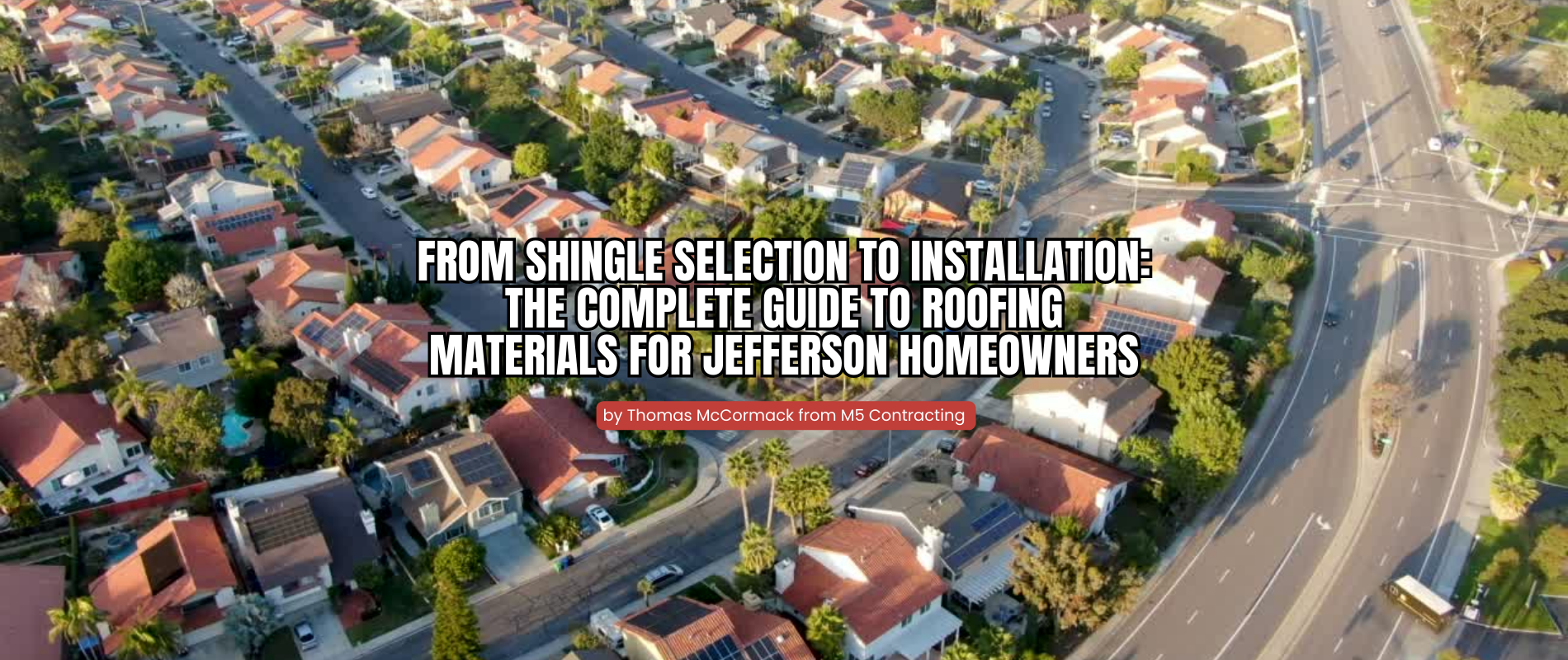From Shingle Selection to Installation: The Complete Guide to Roofing Materials for Jefferson Homeowners
Good morning Jefferson! It's
Thomas here again with another edition of our storm restoration blog dedicated to helping Missouri homeowners understand their homes and the various systems that make up your home!
Today we're taking a look everything from shingles to installation which means today blog is dedicated to your roofing system. Let's get started!
Introduction to Roofing Materials: Understanding Your Options

Asphalt Shingles: Versatile and Cost-Effective Solutions
In the realm of roofing materials, few options can rival the durability and longevity of metal roofing. For Jefferson homeowners seeking unparalleled protection against the elements, metal roofing stands out as a top choice, offering a host of benefits that make it a wise investment for any property.
Exceptional Durability and Longevity
One of the primary advantages of metal roofing is its exceptional durability. Unlike traditional roofing materials such as asphalt shingles or wood shakes, metal roofing is engineered to withstand the harshest weather conditions with ease. From heavy rain and snow to high winds and hail, metal roofing provides reliable protection year-round, ensuring peace of mind for homeowners in Jefferson and beyond.
Moreover, metal roofing boasts an impressive lifespan that far surpasses that of other roofing materials. While asphalt shingles may need to be replaced every 15 to 20 years, metal roofing can last 50 years or more with proper maintenance. This longevity not only minimizes the need for frequent repairs and replacements but also translates to significant cost savings over the lifespan of the roof.
Resistance to Fire, Wind, and Pests
In addition to its durability and longevity, metal roofing offers superior resistance to fire, wind, and pests. Unlike combustible materials such as wood shakes or asphalt shingles, metal roofing is non-combustible, making it an ideal choice for areas prone to wildfires. This fire-resistant quality not only protects the home from external threats but also reduces the risk of fire spreading within the structure.
Furthermore, metal roofing is engineered to withstand high winds and extreme weather events, making it an excellent choice for regions like Jefferson that experience fluctuating weather patterns. Whether facing strong gusts during a thunderstorm or enduring the force of a tornado, metal roofing provides steadfast protection that can withstand the test of time.
Exploring Metal Roofing Materials
When it comes to metal roofing, homeowners have a variety of materials to choose from, each offering its own set of benefits and considerations.
1. Steel Roofing:
Steel roofing is renowned for its strength and durability, making it a popular choice for residential and commercial applications alike. Available in a variety of profiles and finishes, steel roofing offers versatility and longevity that make it well-suited to Jefferson's climate.
2. Aluminum Roofing:
Aluminum roofing is prized for its lightweight yet durable properties, making it an ideal choice for areas with high humidity or coastal exposure. Resistant to corrosion and rust, aluminum roofing is an excellent option for Jefferson homeowners seeking long-lasting protection against the elements.
3. Copper Roofing:
Copper roofing is revered for its timeless beauty and unmatched longevity, with some copper roofs lasting centuries. While copper roofing may require a higher upfront investment, its distinctive appearance and resistance to corrosion make it a popular choice for historic homes and upscale properties in Jefferson.
In summary, metal roofing offers Jefferson homeowners durable and long-lasting protection that far surpasses that of traditional roofing materials. With its exceptional durability, resistance to fire, wind, and pests, as well as a variety of material options to choose from, metal roofing stands out as a superior choice for those seeking lasting peace of mind and unmatched performance for their homes.

Tile Roofing: Classic Elegance with Lasting Performance
When it comes to roofing materials that combine timeless elegance with unmatched durability, tile roofing stands out as a top choice for Jefferson homeowners. With its distinctive appearance and long history of use in architecture around the world, tile roofing not only enhances the curb appeal of homes but also provides superior protection against the elements, making it a wise investment for those seeking both style and functionality.
Timeless Appeal and Curb Appeal Enhancement
One of the most notable features of tile roofing is its timeless appeal, which adds a touch of classic elegance to any home. Whether adorning a historic residence or a modern abode, tile roofing exudes sophistication and charm, elevating the aesthetic appeal of the entire property. In Jefferson, where architectural diversity is celebrated, tile roofing offers an opportunity for homeowners to make a bold statement while maintaining a sense of tradition and heritage.
Moreover, tile roofing has a distinct advantage when it comes to enhancing curb appeal. With its wide range of colors, textures, and profiles, tile roofing allows homeowners to customize their roofs to complement the architectural style of their homes and reflect their personal taste. Whether opting for the warm earth tones of clay tiles or the sleek modern look of concrete tiles, Jefferson homeowners can achieve a striking visual impact that sets their property apart from the rest.
Advantages of Various Types of Tile Roofing
Tile roofing encompasses a variety of materials, each offering its own unique advantages and characteristics that contribute to its lasting performance.
1. Clay Tiles:
Clay tiles are revered for their natural beauty, rich colors, and unmatched durability. Made from natural clay fired at high temperatures, clay tiles are inherently resistant to fire, rot, and insect damage, making them an ideal choice for Jefferson homeowners seeking long-lasting protection against the elements. Additionally, clay tiles have excellent thermal properties, helping to regulate indoor temperatures and reduce energy costs throughout the year.
2. Concrete Tiles:
Concrete tiles are known for their strength, versatility, and affordability. Available in a wide range of shapes, sizes, and finishes, concrete tiles offer Jefferson homeowners endless design possibilities to suit their preferences and architectural style. With their durable composition and resistance to weathering, concrete tiles provide reliable protection against wind, rain, and hail, ensuring peace of mind for years to come.
3. Slate Tiles:
Slate tiles epitomize luxury and sophistication, with their natural beauty and unique texture adding a touch of elegance to any home. Quarried from natural stone, slate tiles boast exceptional durability and weather resistance, making them a popular choice for upscale properties in Jefferson. While slate roofing may require a higher upfront investment, its timeless beauty and longevity make it a worthwhile investment for homeowners seeking unparalleled quality and performance.
In conclusion, tile roofing offers Jefferson homeowners a perfect blend of classic elegance and lasting performance that enhances the beauty and value of their properties. Whether opting for the rich hues of clay tiles, the versatility of concrete tiles, or the luxurious appeal of slate tiles, homeowners can enjoy a roofing solution that not only stands the test of time but also makes a lasting impression for generations to come.
Factors to Consider in Roofing Material Selection and Installation
Choosing the right roofing material for your Jefferson home is a significant decision that can impact your property's aesthetics, functionality, and long-term value. With a multitude of options available, it's essential to carefully consider various factors to ensure you make an informed choice that meets your specific needs and preferences. From cost and durability to energy efficiency and maintenance requirements, here's a comprehensive guide to help you navigate the selection and installation process with confidence.
1. Cost:
Cost is often a primary consideration for homeowners when selecting roofing materials. While upfront expenses are important to factor in, it's essential to also consider long-term costs, including maintenance and potential repairs. While some materials may have a higher initial investment, they may offer greater durability and longevity, ultimately saving you money over time.
2. Durability:
Durability is paramount when selecting roofing materials, particularly in regions like Jefferson, where weather conditions can be unpredictable. Consider the material's resistance to factors such as wind, rain, hail, and UV exposure. Materials like metal and tile roofing tend to offer superior durability compared to asphalt shingles, which may require more frequent repairs or replacements.
3. Energy Efficiency:
Energy efficiency is becoming an increasingly important consideration for homeowners seeking to reduce their environmental impact and lower utility bills. Some roofing materials, such as metal and cool roof coatings, are designed to reflect more sunlight and absorb less heat, helping to keep your home cooler in the summer and reduce energy consumption for air conditioning.
4. Maintenance Requirements:
Different roofing materials have varying maintenance requirements, ranging from minimal upkeep to regular inspections and repairs. Consider your willingness and ability to maintain the roof over time, including factors such as cleaning, sealing, and repairing damaged areas. Materials like asphalt shingles and metal roofing typically have lower maintenance needs compared to wood shakes or slate tiles.
Proper Installation Techniques and Professional Contractors
Equally important to selecting the right roofing material is ensuring it is installed correctly. Proper installation techniques are critical to the performance, longevity, and warranty coverage of your roof. While DIY installation may seem appealing, it's often best to enlist the expertise of professional roofing contractors who have the knowledge, experience, and equipment to execute the job safely and effectively.
Professional roofing contractors can assess your home's unique requirements, recommend suitable materials, and ensure the installation adheres to industry standards and local building codes. Additionally, reputable contractors typically offer warranties on their workmanship, providing added peace of mind knowing that your roof is backed by quality craftsmanship.
In conclusion, when selecting roofing materials for your Jefferson home, it's essential to consider factors such as cost, durability, energy efficiency, and maintenance requirements. Additionally, prioritize proper installation techniques and enlist the services of professional roofing contractors to ensure the longevity and performance of your chosen roofing material. By taking these considerations into account, you can make a well-informed decision that enhances the beauty, functionality, and value of your home for years to come.
YouGetARoof Articles and FAQ












